Fine Arts Press
Retail customers within the U.S.: The easiest way to pay for your book order is by clicking on the shopping cart under each publication. PayPal also allows you to use your credit card (after clicking on the PayPal button), or call 415-264-3211 (through Shore Design) and pay by credit card (VISA or Mastercard). We are available after 10am west coast time including most weekends. If there is no answer, please leave your phone number for a return call. Shipments can take up to two weeks to arrive.
Retail customers outside the U.S.: Please email us with the titles you wish to order along with the quantity of each. Please specify hard cover [H], soft cover [S] or limited edition [L] (if available) as well as your complete mailing address. We will contact you with the correct shipping/handling charge and total due. You can pay through PayPal or credit card (VISA or Mastercard). Shipments can take up to two weeks to arrive.
Wholesale book buyers: Please email us with the title(s) you wish to order. Specify hard cover [H], soft cover [S] or limited edition [L] (if available) as well as the quantity of each. We will email you the shipping surcharge and total wholesale amount due. You can pay through PayPal, credit card or mail us a check. If you do not have an account with Fine Arts Press, please call us at 415-264-3211 (through Shore Design) or email us to set up an account. Nine or less copies ordered receive a 25% discount and ten or more copies ordered receive a 48% discount. Books ordered can be a combination of titles in order to satisfy quantity discount. Shipping is additional.
Frances McCormack
Rooted in Wonder: Paintings, 1984-2024
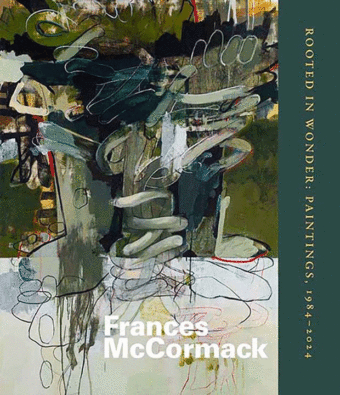 This handsome 160-page monograph is being published in conjunction with the exhibition Frances McCormack: Rooted in Wonder, organized by the di Rosa Center for Contemporary Art.
This handsome 160-page monograph is being published in conjunction with the exhibition Frances McCormack: Rooted in Wonder, organized by the di Rosa Center for Contemporary Art.
Lush paintings and vibrant collages by Frances McCormack are given their due in this richly illustrated, 40-year survey. Highlighting McCormack’s use of the garden as a guiding metaphor, essayist Signe Mayfield traces McCormack’s creative evolution from figurative painting to expressions in gestural abstraction. There are many avenues into abstraction, but McCormack’s is singular given its recognizable motifs and underlying forms with their meaningful connection to the artist’s personal history.
McCormack’s own essay contributions— “Why Painting” and “Wonder and Limitation”— reveal her thoughts on inspirations, creative process, recent work in collage, and approaches to teaching. The Sonoma-based painter taught studio art at San Francisco State University, Sonoma State University, California College of the Arts (Oakland and San Francisco campuses)—and most extensively during a 28-year period at the former San Francisco Art Institute [SFAI] as a tenured faculty. Among her numerous honors, this respected Bay Area artist was the first affiliated SFAI Fellow at the American Academy in Rome in July 2000.
- ISBN: 13:978-09978390-6-7
- Published by Fine Arts Press
- By Signe S. Mayfield and Frances McCormack
- Format: hard cover
- Dimensions: 9 x 10.5 in.
- 160 page
- Price: $38
- Order number: FAP-144-H
THE OBJECT IN ITS PLACE
Ted Cohen & The Art of Exhibition Design
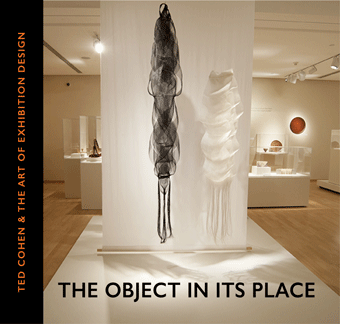 Focusing on the creative life and lessons of the prominent 92-year old museum exhibition designer, Ted Cohen, this visually driven book offers useful information on the design form, while promising to illuminate creative possibilities for the readers’ own unique spaces. In thinking about an exhibition, most people recall its objects—not the spaces between, its color or architectural details. In this sense, exhibition design is a silent art—never to be cherished over collections on display, yet crucial in engaging viewers. Cohen is a master, who has created over 800 exhibitions for nearly 30 museums, as well as installations in hospitals and private collections,
Focusing on the creative life and lessons of the prominent 92-year old museum exhibition designer, Ted Cohen, this visually driven book offers useful information on the design form, while promising to illuminate creative possibilities for the readers’ own unique spaces. In thinking about an exhibition, most people recall its objects—not the spaces between, its color or architectural details. In this sense, exhibition design is a silent art—never to be cherished over collections on display, yet crucial in engaging viewers. Cohen is a master, who has created over 800 exhibitions for nearly 30 museums, as well as installations in hospitals and private collections,
This hardbound book is a handsome, limited edition of interest to anyone working in or interested in museum exhibition design, as well as residential design. Along with historic and contemporary images and extensive text, it includes a large series of informative “lessons” that are based on Cohen’s teachings in exhibition design.
- ISBN – 978-0-9978390-5-0
- Published by the Mingei Museum, San Diego in cooperation with Fine Arts Press and in association with the Oakland Museum and the Museum of Craft and Design, San Francisco
- By Signe S. Mayfield with texts by Ted Cohen, Lori Fogarty, Linda Craighead, JoAnn Edwards
- Format: hard cover
- Dimensions: 9.75: x 9.75″
- 172 pages plus cover with 200 images
- Publication year: 2020
- Price: $32.00
- order number FAP-143-H
Sentido – Paintings by Bob Nugent
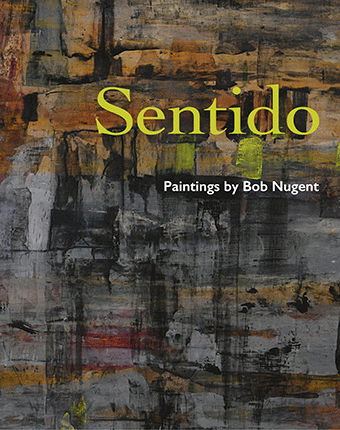 “There is a word in Portuguese, sentido, that has to do with experiencing things with all one’s senses. Not just to transfer what you have seen but to use all your senses to record the place or object. That is what my work is about.” Bob Nugent
“There is a word in Portuguese, sentido, that has to do with experiencing things with all one’s senses. Not just to transfer what you have seen but to use all your senses to record the place or object. That is what my work is about.” Bob Nugent
Bob Nugent first became interested in the indigenous peoples and rain forests of Brazil during a seminal visit to São Paulo in 1984. Here, among the rain forests and Amazonian vistas, the artist found the raw vitality of nature, sometimes in its undisturbed fullness, and sometimes as impacted by the incursions of man. Over the subsequent 36 years he would return again and again to the region to continue his research and study the flora and fauna of the Amazon Region and other parts of the country.
Already, Nugent’s art was being recognized and praised. In 1977 he received a Louis Comfort Tiffany Foundation Artist Fellowship, and one year later a National Endowment for the Arts Individual Fellowship. But what would follow after his initial visit to Brazil was a succession of awards and recognitions for his work in portraying the meld of Amazonian life with the abstracted emotionality of our “civilized” response to it. A Fulbright grant, California Arts Council Artist Fellowship, U.S. State Department Cultural Exchange Grant, and others enabled him to continue what would become a life-long mission of depicting this world and its transformation before our very eyes.
- ISBN – 978-0-9978390-3-6
- Published by Fine Arts Press
- Essays by Maria Esther Fernandez, Preston Metcalf, Fabio Magalhaes, Roberto Elisabetsky
- Format: hard cover
- dimensions: 9.5″ x 12″
- 160 pages with 90 color images
- Price: $36.00
- order number: FAP-142-H
Sacred Deities of Ancient Egypt
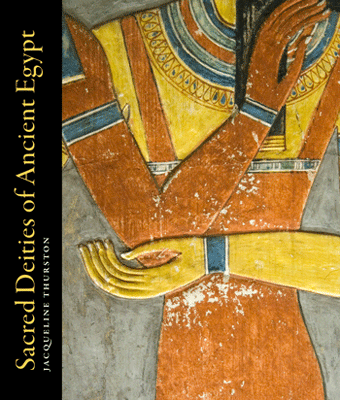 Written from the perspective of an artist with a deep and abiding interest in the psychoanalytic roots of symbol and metaphor, and “illustrated” with her own photographs, Sacred Deities of Ancient Egypt takes us on a personal journey to explore both the meaning—always with an eye toward contemporary relevance—and the astonishing beauty of ancient Egyptian art. With Thurston as our guide, we do not tread on familiar ground or rehash information found elsewhere, but rather participate in the artist’s quest for fresh insight as we plumb the profound depths of Egyptian cosmology.
Written from the perspective of an artist with a deep and abiding interest in the psychoanalytic roots of symbol and metaphor, and “illustrated” with her own photographs, Sacred Deities of Ancient Egypt takes us on a personal journey to explore both the meaning—always with an eye toward contemporary relevance—and the astonishing beauty of ancient Egyptian art. With Thurston as our guide, we do not tread on familiar ground or rehash information found elsewhere, but rather participate in the artist’s quest for fresh insight as we plumb the profound depths of Egyptian cosmology.
Working alone, carrying her own equipment, photographing with an unobtrusive handheld camera, without access to a tripod or a flash, a woman in her late sixties, a solo traveler in a foreign land, Thurston faced daunting technical challenges. The dark interiors of tombs and grand temples of ancient Egypt, unevenly lit with fluorescent panels that cast a garish greenish glow on the lower portion of the walls, leaving the upper walls in shadow and distorting the paintings’ colors, were nightmarish. Many of the photographs in Sacred Deities have never before been reproduced.
ISBN – 13:978-0-9885787-9-1
published by Fine Arts Press
author and photographer: Jacqueline Thurston
introduction: Susan Landauer
format: hard cover
dimensions: 8.5″ x 10″
224 pages with 185 color plates
Regular edition: $36.00
Limited signed edition: $42.00
order number: FAP-141-H
Regular edition:
Limited signed edition:
Anchors in Time – Dominic Di Mare
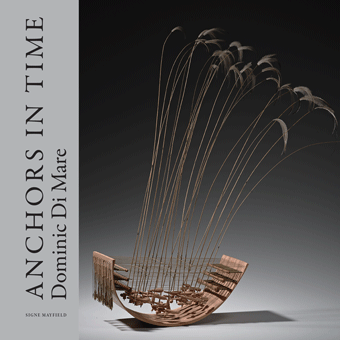 This handsome book documents the work of Dominic Di Mare who pioneered dimensional weaving in the 1960s and forged new sculptural directions with cast paper in the 1970s. He received further acclaim from the 1970s through the 1990s for expanding the use of mixed media in intimate sculptures: first by combining knotted linen with clay, and later by combining branches with delicate feathers, beads, paper, and horsehair. Though these are simple materials, in Di Mare’s hands they were transformed into works seen as intensely poetic, enigmatic, or relaying a spiritual presence. In the past few decades, the object maker reset his compass to explore luminous watercolor on paper in a singular way. He made precise cutouts in his unique artist’s books to provide alluring clues for subsequent pages, while in the flat watercolors of his surreal self-portrait series, he painted such dense compositions that there is an illusion of dimensional realms. The very name Di Mare translates as “of the sea” and is the legacy of his forebears. Repetition bears additional meanings within the heartbeat of his work. Dominic Di Mare’s work is an eloquent reminder of art’s power to transmute the personal into signs and symbols of the universal to connect with our own imagination.
This handsome book documents the work of Dominic Di Mare who pioneered dimensional weaving in the 1960s and forged new sculptural directions with cast paper in the 1970s. He received further acclaim from the 1970s through the 1990s for expanding the use of mixed media in intimate sculptures: first by combining knotted linen with clay, and later by combining branches with delicate feathers, beads, paper, and horsehair. Though these are simple materials, in Di Mare’s hands they were transformed into works seen as intensely poetic, enigmatic, or relaying a spiritual presence. In the past few decades, the object maker reset his compass to explore luminous watercolor on paper in a singular way. He made precise cutouts in his unique artist’s books to provide alluring clues for subsequent pages, while in the flat watercolors of his surreal self-portrait series, he painted such dense compositions that there is an illusion of dimensional realms. The very name Di Mare translates as “of the sea” and is the legacy of his forebears. Repetition bears additional meanings within the heartbeat of his work. Dominic Di Mare’s work is an eloquent reminder of art’s power to transmute the personal into signs and symbols of the universal to connect with our own imagination.
- ISBN – 10:0-9885787-6-x
- Published by Fine Arts Press
- By Signe Mayfield with essays by W. S. Di Piero, Michael W. Monroe
- Format: hard cover
- Dimensions: 9.5″ x 9.5″
- 176 pages plus cover with over 130 images
- Publication year: 2018
- Price: $28.00
- order number: FAP-140-H
Eureka at Thirty Years
Fleishhacker Foundation Artist Fellowships
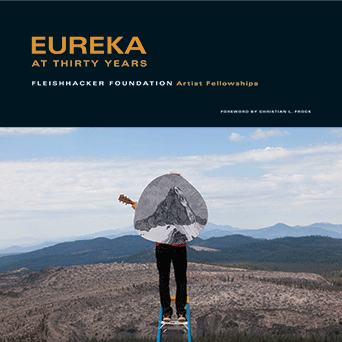 The Fleishhacker Foundation is a family foundation. It was established in 1947 to improve the quality of life in the San Francisco Bay Area. The Foundation makes grants to local, community- based artists and organizations through two main programs: Arts & Culture and K–5 Literacy Education.
The Fleishhacker Foundation is a family foundation. It was established in 1947 to improve the quality of life in the San Francisco Bay Area. The Foundation makes grants to local, community- based artists and organizations through two main programs: Arts & Culture and K–5 Literacy Education.
The Eureka Fellowship Program makes grants to individual visual artists. Artists are nominated by local nonprofit arts organizations to qualify. Awards of $25,000 per artist are determined by a review panel of non-Bay Area arts experts, and are unrestricted.
This publication is a celebration of 30 years of grantmaking through the Eureka Fellowship program and includes a complete timeline of current and past grantees, and grantee feature pages for our 2019–2008 awardees.
- ISBN – 10:0-9885787-8-6
Published by The Fleishhacker Foundation
Foreword by Christian L. Frock
Format: soft cover
Dimensions: 9.5″ x 9.5″
108 pages plus cover, 94 artists’ plates
Publication year: 2017
Price: $24.00
order number: FAP-139-S
Sandy Swirnoff: Knotted Fiber Jewelry
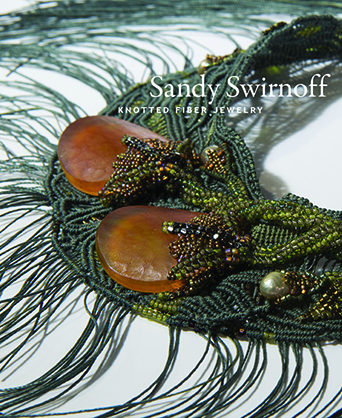 In this publication, you will discover knotting at its highest level; refined work that gives new meaning to the word macramé. You will also see a sophisticated and imaginative sense of design and a subtle use of color. In this labor-intensive, delicate work, Sandy Swirnoff draws on a deep and intuitive creative drive, supported by serious study with well-known teachers. Swirnoff expresses a unique sensibility in this unusual art form and has created settings perfectly in synch with glass jewels by Tiffany, Daume, and Gallé in style, color, refinement, and appropriateness. She has not just rescued art-glass shards. She has given them life as new works of art, synergistically melding the work of two artists, in two mediums, across two centuries—an accomplishment of great skill and inventiveness.
In this publication, you will discover knotting at its highest level; refined work that gives new meaning to the word macramé. You will also see a sophisticated and imaginative sense of design and a subtle use of color. In this labor-intensive, delicate work, Sandy Swirnoff draws on a deep and intuitive creative drive, supported by serious study with well-known teachers. Swirnoff expresses a unique sensibility in this unusual art form and has created settings perfectly in synch with glass jewels by Tiffany, Daume, and Gallé in style, color, refinement, and appropriateness. She has not just rescued art-glass shards. She has given them life as new works of art, synergistically melding the work of two artists, in two mediums, across two centuries—an accomplishment of great skill and inventiveness.
- ISBN – 10:0-9885787-7-8
Published by Mingei International Museum
Author: Karen Searle
Format: soft cover
Dimensions: 9″ x 11″
76 page plus cover / 62 color plates
Publication year: 2016
price: $22.98
order number: FAP-138-S
Layers of Brilliance
The Journey of Japanese Lacquer Tools
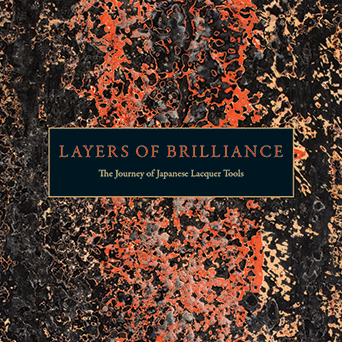 “Layers of Brilliance” features the tools used by Japanese makers of everyday lacquer objects. Messy in their appearance, these seemingly humble objects also “mess” with, or disturb, the distinction between the processual work of art and the finished work of art. Many of these pieces are uncertain and unstable in their identity. As a group, they belong to—and thus mediate between—the categories of the functional instrument used in the craft process and the aestheticized and theorized art object meant to be collected and thus exhibited. As implements of prolonged use, these humble, functional boards, bowls, buckets, drawers, and shelves were deployed to produce everyday lacquered items like bowls and cups. Today, in their myriad colorful drips and accumulated layers of viscous texture, they bear witness to the countless lacquered objects created from them.
“Layers of Brilliance” features the tools used by Japanese makers of everyday lacquer objects. Messy in their appearance, these seemingly humble objects also “mess” with, or disturb, the distinction between the processual work of art and the finished work of art. Many of these pieces are uncertain and unstable in their identity. As a group, they belong to—and thus mediate between—the categories of the functional instrument used in the craft process and the aestheticized and theorized art object meant to be collected and thus exhibited. As implements of prolonged use, these humble, functional boards, bowls, buckets, drawers, and shelves were deployed to produce everyday lacquered items like bowls and cups. Today, in their myriad colorful drips and accumulated layers of viscous texture, they bear witness to the countless lacquered objects created from them.
- ISBN – 10:09885787-5-1
Published by Mingei International Museum
Author: Kendall H. Brown
Format: hard cover
Dimensions: 9.75″ x 9.75″
96 page plus cover / 90 color plates
Publication year: 2016
price: $65.00
order number: FAP-137-H
The Art of Agelio Batle
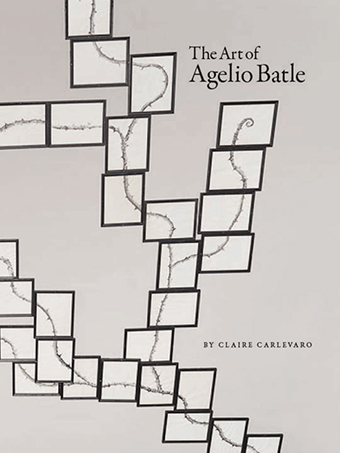 Agelio Batle’s art is based on humanism: the figure and nature are often his inspirations. Whatever the subject, it is liberated from convention by his spirituality and radical transformation of materials. The artist delights in discovering the potential of unusual materials—often cast offs: found photos, plastic milk cartons, discarded reference books, etc. Examples of Agelio’s art are illustrated in this publication. You can see the talent, the vitality, the skill, the adventure. What you have to imagine is the man himself. He is a true seeker, an explorer, a remarkable inspiration to others as an artist, husband, teacher, and father. In addition to his steady creation of unique works, Agelio has invented a graphite product carried by hundreds of museums and shops. He has been commissioned by many creative companies to produce objects of wonder.
Agelio Batle’s art is based on humanism: the figure and nature are often his inspirations. Whatever the subject, it is liberated from convention by his spirituality and radical transformation of materials. The artist delights in discovering the potential of unusual materials—often cast offs: found photos, plastic milk cartons, discarded reference books, etc. Examples of Agelio’s art are illustrated in this publication. You can see the talent, the vitality, the skill, the adventure. What you have to imagine is the man himself. He is a true seeker, an explorer, a remarkable inspiration to others as an artist, husband, teacher, and father. In addition to his steady creation of unique works, Agelio has invented a graphite product carried by hundreds of museums and shops. He has been commissioned by many creative companies to produce objects of wonder.
- ISBN – 10:0-692-74976-4
- Published by Fine Arts Press
- Author: Claire Carlevaro
- Format: soft cover
- Dimensions: 7.5″ x 10″
- 48 page plus cover / 32 illustrations
- Publication year: 2016
- soft cover price: $20.00
- order number: FAP-136-S
Unique work of art by Binh Pho with book
titled River of Destiny – The Life and Work of Binh Pho housed in a limited edition box
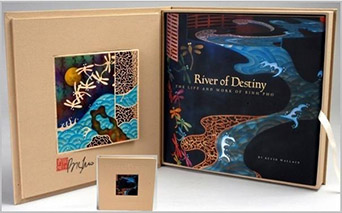 Hard cover book titled “River of Destiny: The Life and Work of Binh Pho” is housed in a limited edition cloth covered box and includes a unique work of art created by the artist. Each artwork is unique, hand-cut and painted by Binh Pho. The book presents the art and story of an important Vietnamese-American artist. A leading figure in the international movement in contemporary wood sculpture, Binh Pho utilizes modernist approaches to painting and sculpture to create bold new work that bridges the decorative arts with concerns for narrative and concept traditionally associated with contemporary art.
Hard cover book titled “River of Destiny: The Life and Work of Binh Pho” is housed in a limited edition cloth covered box and includes a unique work of art created by the artist. Each artwork is unique, hand-cut and painted by Binh Pho. The book presents the art and story of an important Vietnamese-American artist. A leading figure in the international movement in contemporary wood sculpture, Binh Pho utilizes modernist approaches to painting and sculpture to create bold new work that bridges the decorative arts with concerns for narrative and concept traditionally associated with contemporary art.
- hardcover ISBN – 0-9729361-3-0
- published by the Long Beach Museum of Art, California
- text by exhibition curator Kevin Wallace
- format: hard cover book with cloth and dust jacket
- book dimensions: 9.25” x 9.25”
- artwork dimensions: approx. 5.25″ x 5.25″
- 88 page plus cover / 72 color plates
- publication year: 2005
- book housed in a limited edition box with a unique work of art by Binh Pho: due to Binh Pho’s death, this limited edition work of art is no longer available
Out of print
The Art and Design of Mardi Gras
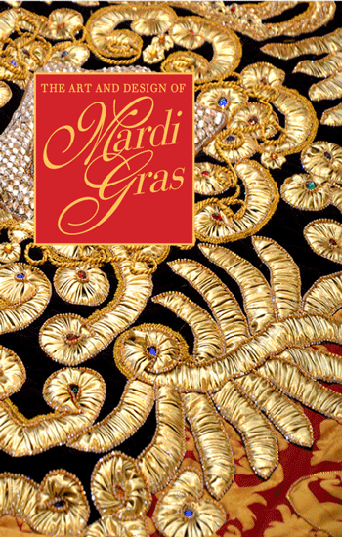 This handsome publication celebrates the oldest continuous Mardi Gras celebration and parades in America. Featured are historic and contemporary photographs, drawings and fanciful artwork of the embroidered, one-of-a-kind costumes for the royal monarchs, mythical floats, masks, posters, elaborate crystal encrusted crowns, scepters, coins, beads, and other Mardi Gras memorabilia. Included are a series of stories that describe the origins of Mardi Gras from the first drunken sailor who tied bells to a rake wandering the streets through the numerous secret societies and balls to the formation of the historic African-American Mardi Gras Association.
This handsome publication celebrates the oldest continuous Mardi Gras celebration and parades in America. Featured are historic and contemporary photographs, drawings and fanciful artwork of the embroidered, one-of-a-kind costumes for the royal monarchs, mythical floats, masks, posters, elaborate crystal encrusted crowns, scepters, coins, beads, and other Mardi Gras memorabilia. Included are a series of stories that describe the origins of Mardi Gras from the first drunken sailor who tied bells to a rake wandering the streets through the numerous secret societies and balls to the formation of the historic African-American Mardi Gras Association.
ISBN – 978-1-893174-08-5
Published by the Mobile Museum of Art
Authors: Steve Joynt, Cartledge Weeden Blackwell III, Scotty E. Kirkland and Karyn Kay Zweifel
Format: soft cover
Dimensions: 7″ x 11″
88 page plus cover / 114 illustrations
Publication year: 2014
soft cover price: $18.95
order number: FAP-135-S
Charles Smith: Black Hands / I am
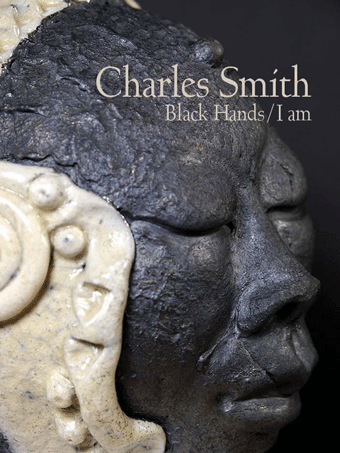 Charles Smith’s work in ceramics, which is typically marked by a very powerful rhythm of uniquely executed sgraffito, includes both functional and non-functional primitively fired forms, as well as sculpture. His work has been celebrated in several written works, such as the article entitled “Alabama Travels” by Gerry Williams for “The Studio Potter” and most recently in the seminal reference of Alabama artists: “Alabama Masters Artists and Their Work.” A portion of his exhibition record includes: “Uncommon Beauty in Common Objects: The Legacy of African American Craft Art,” several locations, 1993; American Craft Museum, New York City; Smithsonian, Washington, D.C., as well as a myriad of venues in the Southeastern part of the United States. His work is included in both important private and public collections with examples being in the permanent collection of his hometown museum at the prestigious Mobile Museum of Art.
Charles Smith’s work in ceramics, which is typically marked by a very powerful rhythm of uniquely executed sgraffito, includes both functional and non-functional primitively fired forms, as well as sculpture. His work has been celebrated in several written works, such as the article entitled “Alabama Travels” by Gerry Williams for “The Studio Potter” and most recently in the seminal reference of Alabama artists: “Alabama Masters Artists and Their Work.” A portion of his exhibition record includes: “Uncommon Beauty in Common Objects: The Legacy of African American Craft Art,” several locations, 1993; American Craft Museum, New York City; Smithsonian, Washington, D.C., as well as a myriad of venues in the Southeastern part of the United States. His work is included in both important private and public collections with examples being in the permanent collection of his hometown museum at the prestigious Mobile Museum of Art.
- ISBN – 978-1-893174-19-1
Published by the Mobile Museum of Art - Author: Paul W. Richelson
- Format: soft cover
- Dimensions: 9″ x 12″
- 48 page plus cover / 22 full page color plates
- Publication year: 2015
- soft cover price: out of print
- order number: FAP-134-S
Out of print
Vermont – An outsider’s inside view
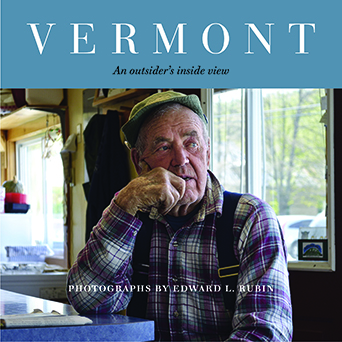 Emmy award-winning art director and international award-winning fine art photographer Edward L. Rubin has created a stunning visual portrait of the people and landscapes of contemporary Vermont. Rubin has photographed everyone from the Governor to goat farmers, artists, mechanics, supreme court justices, waitresses, and activists in beautiful color and black and white photographs revealing life in the Green Mountain State from the unique perspective of an outsider who has been invited to join in and record privileged, private moments. Each plate includes a fascinating story about that subject written by the photographer. His images reveal that there are still places in America where people know each other deeply, help each other freely, and are bound to each other in heart, mind, and community.
Emmy award-winning art director and international award-winning fine art photographer Edward L. Rubin has created a stunning visual portrait of the people and landscapes of contemporary Vermont. Rubin has photographed everyone from the Governor to goat farmers, artists, mechanics, supreme court justices, waitresses, and activists in beautiful color and black and white photographs revealing life in the Green Mountain State from the unique perspective of an outsider who has been invited to join in and record privileged, private moments. Each plate includes a fascinating story about that subject written by the photographer. His images reveal that there are still places in America where people know each other deeply, help each other freely, and are bound to each other in heart, mind, and community.
Published by Fine Arts Press
Text by Edward L. Rubin
Format: hard cover
Dimensions: 12” x 12”
228 page plus cover / 200 color and black and white plates
Publication year: 2016
hard cover: $45.00
Order number: FAP-132-H
Frank E. Cummings III
Jeweled Harmony in Wood
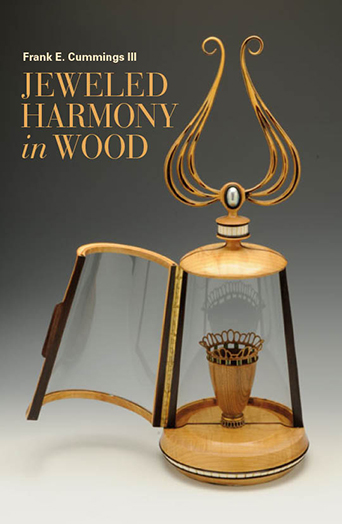 Frank E. Cummings III is an iconic figure in the fields of American studio furniture and woodturning. Cummings refers to himself (and prefers to be known as) an artist. Respected for his slow, careful, meticulous craftsmanship, he also designed furniture for a movie set. Born during the Great Depression in the Watts area of Los Angeles, he faced the challenges every African American encountered during the last half of the twentieth century, but overcame them, embraced the opportunities that came his way, and through hard work achieved his place in the pantheon of contemporary American artists. An example of his work is included in the permanent collection of the White House. Nevertheless, most surveys of African American art overlook his contributions. This beautiful exhibition catalogue features works in various woods, precious stones, mother of pearl, gold, and other exotic materials. This publication was published in conjunction with his one-person exhibition at the Long Beach Museum of Art.
Frank E. Cummings III is an iconic figure in the fields of American studio furniture and woodturning. Cummings refers to himself (and prefers to be known as) an artist. Respected for his slow, careful, meticulous craftsmanship, he also designed furniture for a movie set. Born during the Great Depression in the Watts area of Los Angeles, he faced the challenges every African American encountered during the last half of the twentieth century, but overcame them, embraced the opportunities that came his way, and through hard work achieved his place in the pantheon of contemporary American artists. An example of his work is included in the permanent collection of the White House. Nevertheless, most surveys of African American art overlook his contributions. This beautiful exhibition catalogue features works in various woods, precious stones, mother of pearl, gold, and other exotic materials. This publication was published in conjunction with his one-person exhibition at the Long Beach Museum of Art.
Published by Long Beach Museum of Art
Text by Gerald W. R. Ward
Format: soft cover
Dimensions: 7.25″ x 11″
52 page plus cover
Publication year: 2013
soft cover price: $18.95
soft cover order number: FAP-130-S
Out of print
Sky is Falling
Paintings by Julie Heffernan
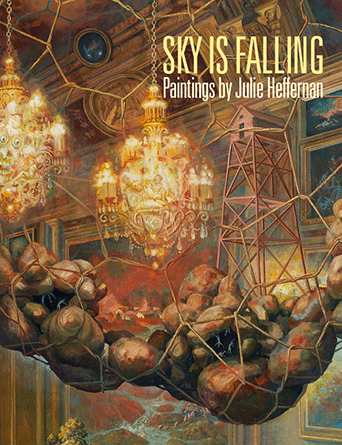 This publication documents the mid-career survey exhibition of the work of Julie Heffernan at the Palo Alto Art Center and the Crocker Art Museum. In these lush canvases, we find echoes of our past and warnings about our future. Stylistic references from throughout the history of painting coexist with allusions to our current cultural fascination with consumption and the role it plays in our environment’s devastation. For the artist, her paintings serve both as creative expressions and calls to action, “cries in the wilderness and my attempt to do something.” Despite the foreboding subject matter, a unique power of Heffernan’s art lies in her ultimate hopefulness, her belief in our power to eventually turn things around. Because, as Julie reminds us, “what we can imagine we can manifest.”
This publication documents the mid-career survey exhibition of the work of Julie Heffernan at the Palo Alto Art Center and the Crocker Art Museum. In these lush canvases, we find echoes of our past and warnings about our future. Stylistic references from throughout the history of painting coexist with allusions to our current cultural fascination with consumption and the role it plays in our environment’s devastation. For the artist, her paintings serve both as creative expressions and calls to action, “cries in the wilderness and my attempt to do something.” Despite the foreboding subject matter, a unique power of Heffernan’s art lies in her ultimate hopefulness, her belief in our power to eventually turn things around. Because, as Julie reminds us, “what we can imagine we can manifest.”
Published by the Palo Alto Art Center
Text by Rebecca Solnit
Format: soft cover
Dimensions: 8.75″ x 11.25″
48 page plus cover / 19 color plates
Publication year: 2013
soft cover: $38.00
order number: FAP-129-S
Shadow of the Turning
New Work by Binh Pho
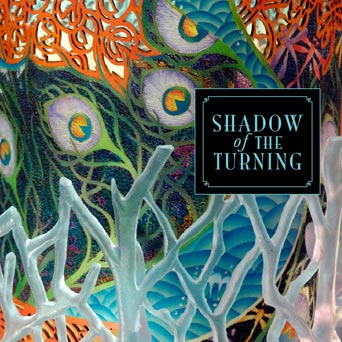
This beautifully illustrated book focuses on art, philosophy and storytelling, yet is an entirely fictional story, blending the mythic worlds of fairy tale, fantasy, romance and adventure. It creates a bridge between literature, art world approaches to concept and narrative and craft traditions. The story is “illustrated” using an exciting new body of work by Binh Pho, which combines wood-turning, sculpture, painting and art glass. As the storyline explores collaboration, a diverse group of international artists were brought together to collaborate with the artist, Binh Pho on works of art that celebrate traditional craft materials and processes that redefine the boundaries of contemporary art.
The author, Kevin Wallace is the Director of the Beatrice Wood Center for the Arts in Ojai, California. He is a regular contributor to numerous international publications and has guest-curated exhibitions for a number of art museums. Previous books by Wallace include “The Cutting Edge: Contemporary Wood Art and the Lipton Collection;” “Celebrating Nature: Craft Traditions/ Contemporary Expressions;” “Transforming Vision: The Wood Sculpture of William Hunter, 1970 – 2005;” “River of Destiny: The Life and Work of Binh Pho;” and “Moulthrop: A Legacy in Wood.”
- Published by Fine Arts Press
- Text by Kevin Wallace
- Art by Binh Pho
- Format: soft cover and hard cover
- Dimensions: 9.25″ x 9.25″
- 264 page plus cover / over 200 color plates
- Publication year: 2012
- soft cover: $36.95
- hard cover: $54.95
- soft cover order number: FAP-128-S
- hard cover order number: FAP-128-H
Soft cover:
Hard cover:
An Artist’s Perspective on the Eye
Paintings by J. McGuinness Myers
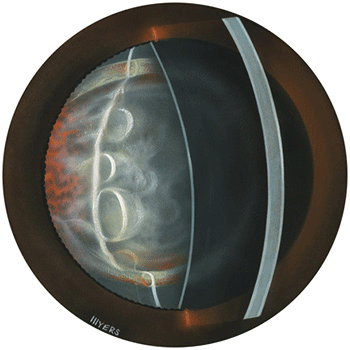 J. McGuinness Myers was a medical illustrator by profession. The paintings and drawings he created on site at the Bascom Palmer Eye Institute at the University of Miami illuminate diseases of the eye and would also intrigue anyone interested in contemporary or abstract art.
J. McGuinness Myers was a medical illustrator by profession. The paintings and drawings he created on site at the Bascom Palmer Eye Institute at the University of Miami illuminate diseases of the eye and would also intrigue anyone interested in contemporary or abstract art.
The variety of his subject matter coupled with his facility with paints, pencil, air-brush and ink is stunning to see. The finished works are immaculate, worthy of the technical skills of a miniaturist. The layman, ignorant of the medical details each picture is provided with, might spin any number of narratives from what is seen on the pages of “An Artist’s Perspective on the Eye.” There are what appear to be Op Art designs, diminishing vistas and swelling curves, images of swimming fish and even the suggestion of dancing flowers. A few of the paintings appear to represent perfect circles of celestial brightness, and one, illuminating the case of a melanoma of the retina, might be taken for a Japanese landscape.
Which is not to diminish the worth of “An Artist’s Perspective on the Eye” as a valuable medical book, nor to turn the tables on the expectations of art lovers. This volume insures that Myers’ treasured illustrations (along with the accompanying text) will find a degree of permanency.
- Published by The Bascom Palmer Eye Institute in cooperation with Fine Arts Press
- Text by Richard K Forster, MD, Helen L. Kohen, and Andrew A. Moshfeghi, MD, MBA
- Format: hard cover book and a separate, limited edition, hand numbered version of 500 copies housed in a slipcase
- dimensions: 11” x 11”
- 198 page plus cover / 126 illustrations
- hard cover: $42.00
- limited edition with slipcase: $60.00
- hard cover order number: FAP-125-H
- limited edition with slipcase order number: FAP-125-L
Hard cover:
Limited edition with slip case:
Black Power * Flower Power
Photographs by Pirkle Jones
and Ruth-Marion Baruch
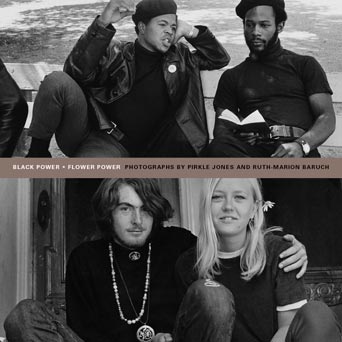 “Black Power * Flower Power” documents two of the most fascinating stories of 20th century America’s cultural history—the growth of the Black Liberation Movement embodied by the Black Panthers and the 1967 blossoming of hippie “flower power” in San Francisco’s Haight Ashbury district.
“Black Power * Flower Power” documents two of the most fascinating stories of 20th century America’s cultural history—the growth of the Black Liberation Movement embodied by the Black Panthers and the 1967 blossoming of hippie “flower power” in San Francisco’s Haight Ashbury district.
Photographers Pirkle Jones and Ruth-Marion Baruch masterfully documented the early days of the Black Panther Party in the San Francisco bay area. This significant movement changed the fabric of the United States. Their photographs profoundly chronicle the influence on American social, political and cultural life and suggest the universal theme of family, commitment, and hope for the future.
Ruth-Marion Baruch’s photographs of San Francisco’s Haight-Ashbury during the Summer of Love in 1967 depicts a Mecca transformed by the psychedelic music, fashion, and anti-war sentiment of the counterculture movement.
- Soft cover ISBN: 978-0-9819933-7-9
- Hard cover ISBN: 978-0-9819933-8-6
- Published by The Pirkle Jones Foundation in cooperation with Fine Arts Press
- Text by Jeff Gunderson, Ruth-Marion Baruch and Paul Liberatore
- Format: soft cover and hard cover
- dimensions: 12” x 12”
- 144 page plus cover / 90 plates
- publication now available
- soft cover: $28.00
- hard cover: $34.00
- soft cover order number: FAP-127-S
- hard cover order number: FAP-127-H
Soft cover:
Hard cover:
Exchange + Evolution
Worldwide Video Long Beach 1974–1999
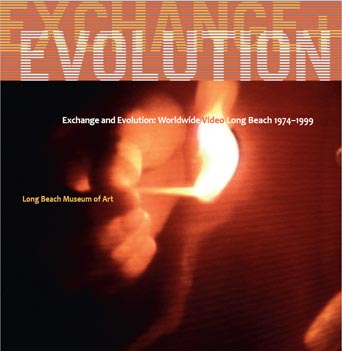 The history of video, in Southern California and at the Long Beach Museum of Art, is one of exchange (the sharing of technical skills and aesthetic approaches as well as critical and idealistic beliefs) and evolution (the exhibition and chronicling of the development of the medium over a period of twenty-five years). LBMA’s account is historically significant. In 1974, only four years after the Public Broadcasting Service (PBS) began in the United States, LBMA launched a program of video art, a radical move by a small museum. This important decision not only brought LBMA into the international contemporary art stream, it also influenced and validated the (then) new medium that remains at the foundation of media art today.
The history of video, in Southern California and at the Long Beach Museum of Art, is one of exchange (the sharing of technical skills and aesthetic approaches as well as critical and idealistic beliefs) and evolution (the exhibition and chronicling of the development of the medium over a period of twenty-five years). LBMA’s account is historically significant. In 1974, only four years after the Public Broadcasting Service (PBS) began in the United States, LBMA launched a program of video art, a radical move by a small museum. This important decision not only brought LBMA into the international contemporary art stream, it also influenced and validated the (then) new medium that remains at the foundation of media art today.
- Soft cover ISBN – 9780971277205
- Hard cover ISBN – 9780971277212
- published by the Long Beach Museum of Art
- text by Ronald C. Nelson, Kathy Rae Huffman, Nancy Buchanan, Glenn Phillips, Wulf Herzogenrath, David A. Ross, Gloria Sutton, Erika Suderberg and Norman Klein
- format: soft cover and hard cover
- dimensions: 9.5” x 9.5”
- 164 page plus cover / 69 plates
- publication year: 2011
- soft cover: $35.00
- hard cover: $45.00
- soft cover order number: FAP-126-S
- hard cover order number: FAP-126-H
Soft cover:
Hard cover:
San Diego’s Craft Revolution
From Post-War Modern to California Design
 San Diego’s Craft Revolution – From Post-War Modern to California Design reveals the important contribution of San Diego craftsmen to the post-war Southern California art scene. From the postwar period beginning in the 1940s up through the 1970s, San Diego’s Craft Revolution explores the progression from sleek modernism to unconventional handmade objects of use such as furniture, doors, jewelry and ceramics. Over 60 artists are featured in the book, including Toza and Ruth Radakovich, Rhoda Lopez, Jack Hopkins, Arline Fisch, Martha Longenecker, Ellamarie and Jackson Woolley, Larry Hunter, Kay Whitcomb and James Hubbell. Many of these San Diego-based artists received national attention and participated in major Los Angeles exhibitions, including the California Design series held in Pasadena and Los Angeles.
San Diego’s Craft Revolution – From Post-War Modern to California Design reveals the important contribution of San Diego craftsmen to the post-war Southern California art scene. From the postwar period beginning in the 1940s up through the 1970s, San Diego’s Craft Revolution explores the progression from sleek modernism to unconventional handmade objects of use such as furniture, doors, jewelry and ceramics. Over 60 artists are featured in the book, including Toza and Ruth Radakovich, Rhoda Lopez, Jack Hopkins, Arline Fisch, Martha Longenecker, Ellamarie and Jackson Woolley, Larry Hunter, Kay Whitcomb and James Hubbell. Many of these San Diego-based artists received national attention and participated in major Los Angeles exhibitions, including the California Design series held in Pasadena and Los Angeles.
- ISBN – 978-0-914155-29-4
- published by the Mingei International Museum
- text by Dave Hampton
- format: hard cover
- dimensions: 9.5″ x 9.5″
- 178 page plus cover / 200+ color plates
- publication year: 2011
- hard cover: $65 (out of print)
- Only 2 copies available!
- hard cover order number: FAP-124 H
Ursula O’Farrell – Emotion in Motion
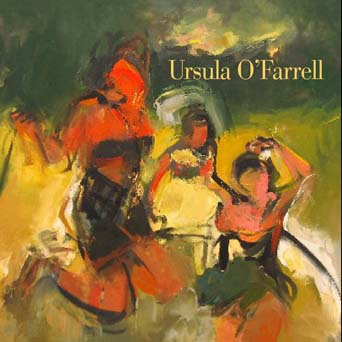 Back in the 1950s a group of painters in the San Francisco Bay Area established what came to be known as Bay Area Figurative Painting. Originally David Park, Elmer Bischoff and Richard Diebenkorn, painters who had all done abstract pictures, decided to embark on figuration which was indebted to abstract gesture painting, but looked again at the world of appearances for their subjects. They even painted from the life model which simply was not done by the Abstract Expressionists. A second generation, Joan Brown, Manuel Neri, Bruce McGaw and others made this new approach to painting (or sculpting) the human figure, into their own and endowed it with a new spirit. Ursula O’Farrell can be said to represent a third generation which includes Christopher Brown and Roger Hermann.
Back in the 1950s a group of painters in the San Francisco Bay Area established what came to be known as Bay Area Figurative Painting. Originally David Park, Elmer Bischoff and Richard Diebenkorn, painters who had all done abstract pictures, decided to embark on figuration which was indebted to abstract gesture painting, but looked again at the world of appearances for their subjects. They even painted from the life model which simply was not done by the Abstract Expressionists. A second generation, Joan Brown, Manuel Neri, Bruce McGaw and others made this new approach to painting (or sculpting) the human figure, into their own and endowed it with a new spirit. Ursula O’Farrell can be said to represent a third generation which includes Christopher Brown and Roger Hermann.
O’Farrell has focused her painting almost entirely on the depiction of women, reflecting no doubt a concern about her own identity. These canvases are done by an artist who has absorbed the lessons of Action Painting and are done with a vigorous brush, probably also with a palette knife and a trowel with lush paint slathered on to the support. Some may seem unrestrained at first look, but they follow their own order—as a 17th Century Chinese landscape painter once said: “The brush is for saving the world from chaos.” Her women, lost in thought, seated, lying, waiting, praying, dancing are all self-absorbed. Above all, they are her reasons for painting.
- soft cover ISBN – 978-0-9819933-5-5
published by Fine Arts Press
text by Peter Selz, Mark Van Proyen, and Maureen Davidson
format: soft cover only
dimensions: 11″ x 11″
104 page plus cover / 50 color plates
publications year: 2011 - Soft cover: $38
order number: FAP-123 S
Bold Expressions
African American Quilts from the Collection of Corrine Riley
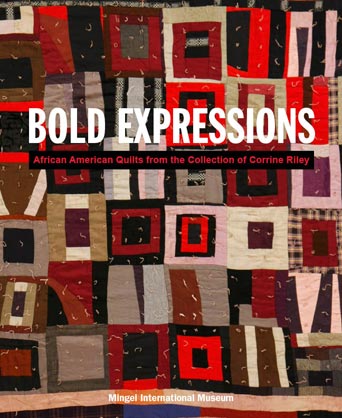 Through most of the 19th and 20th centuries quilts have been perhaps the least visible of American folk art and self-taught art expressions. Unlike weather vanes and paintings, quilts are relatively large and fragile, and this limited them to a special area of collecting. The African American quilts in this book represent a creative departure that until recently had not been widely appreciated. Beginning in 2002, however, the quilts of Gee’s Bend-a remote African American community in Alabama-were exhibited at major museums throughout the United States, including New York’s Museum of Modern Art. These exhibitions shocked the art world, and record-breaking crowds attended them because of the quilts’ audacious graphic originality and power. Critics and public alike realized that these humble creations were as modern and sublime as any of the art hanging in the other galleries within the museums.
Through most of the 19th and 20th centuries quilts have been perhaps the least visible of American folk art and self-taught art expressions. Unlike weather vanes and paintings, quilts are relatively large and fragile, and this limited them to a special area of collecting. The African American quilts in this book represent a creative departure that until recently had not been widely appreciated. Beginning in 2002, however, the quilts of Gee’s Bend-a remote African American community in Alabama-were exhibited at major museums throughout the United States, including New York’s Museum of Modern Art. These exhibitions shocked the art world, and record-breaking crowds attended them because of the quilts’ audacious graphic originality and power. Critics and public alike realized that these humble creations were as modern and sublime as any of the art hanging in the other galleries within the museums.
Corrine Riley’s collection, exhibited at the Mingei International Museum and documented in this beautifully illustrated catalogue, broadened dramatically the scope of our appreciation for the phenomenon of African American quilt art. Her collection has been “picked” from almost every state in the South, and it features examples from hundreds of artists. Though none of these creators would call themselves artists, the work itself speaks otherwise. This 96 page publication includes pieces made by individuals as well as groups of women working together as families and communities.
- soft cover ISBN – 978-0-914155-28-7
- published by Mingei International Museum
- text by Corrine Riley, and Roger Ricco
- format: soft cover only
- dimensions: 9″ x 11″
- 96 page plus cover / 53 color plates
- publications year: 2011
- soft cover: out of print
- order number: FAP-122 S
- out of print
Out of print
Michael Cooper
A Sculptural Odyssey, 1968–2011
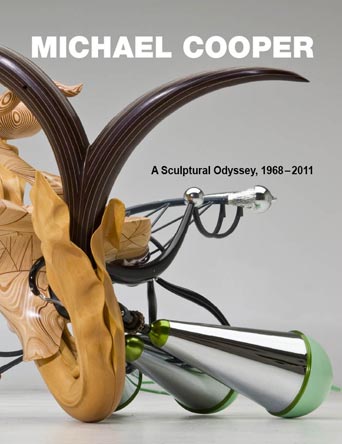 Michael Cooper is an incomparable artist who relentlessly challenges and expands any preconceived boundaries between art, craft, and design with his feet firmly planted in all worlds. Cooper’s outrageous contraptions command and merit our high regard, inciting curiosity and pure wonder in those who experience them. Suspended between technological invention and creative genius, his work is accessible to all, yet like none seen before. Recognized for its flawless precision and craftsmanship, his sculpture continues to be admired by those who appreciate his brilliance of design and the junction between art and science. Cooper is completely driven in his practice and expends huge amounts of time conjuring ideas and bringing them to fruition.
Michael Cooper is an incomparable artist who relentlessly challenges and expands any preconceived boundaries between art, craft, and design with his feet firmly planted in all worlds. Cooper’s outrageous contraptions command and merit our high regard, inciting curiosity and pure wonder in those who experience them. Suspended between technological invention and creative genius, his work is accessible to all, yet like none seen before. Recognized for its flawless precision and craftsmanship, his sculpture continues to be admired by those who appreciate his brilliance of design and the junction between art and science. Cooper is completely driven in his practice and expends huge amounts of time conjuring ideas and bringing them to fruition.
Over the years, Cooper’s kinetic sculptures have employed increasingly sophisticated and complex mechanical movements, from relatively straightforward motor-cable-pulley mechanisms of to the microprocessor-controlled pneumatic systems.
The construction of these kinetic pieces relies heavily on a skillful use of steel, wood and aluminum. Some shapes, such as the stamped steel spheres and hemispheres that show up in several of his sculptures, Cooper gets ready-made through his arsenal of mail-order parts catalogs. Others are slightly modified stock parts that he TIG-welds to form his desired shapes; tungsten inert gas welding, when done well, is a very clean way of joining aluminum or steel.
- soft cover ISBN – 987-0-9760119-3-4
- hard cover ISBN – 978-0-9760119-2-7
- published by the Museum of Craft and Design
- text by Harold B. Nelson and Glenn Adamson
- format: soft cover and hard cover
- dimensions: 9.25″ x 12″
- 76 page plus cover / 44 color plates
- publication year: 2011
- soft cover: LIMITED COPIES $24.00
- soft cover order number: FAP-121-S
The Cutting Edge
Contemporary Wood Art
and the Lipton Collection
 Dr. Irving Lipton was instrumental in developing the careers of leading figures in wood art and bringing attention to their work. As these individuals in turn had a major impact on the field, Dr. Lipton’s value as a patron of the arts was invaluable.
Dr. Irving Lipton was instrumental in developing the careers of leading figures in wood art and bringing attention to their work. As these individuals in turn had a major impact on the field, Dr. Lipton’s value as a patron of the arts was invaluable.
“I viewed writing “A Cutting Edge, Contemporary Wood Art and the Lipton Collection” to be a tremendous responsibility,” says the book’s author, Kevin Wallace. “Dr. Lipton’s legacy was so intimately intertwined with the legacies of the artists, and I sought to accurately record the history of the contemporary wood art field.” Toward this end, Wallace created a work that is essentially an oral history of the field of contemporary wood art, told by the artists who created the field, and with commentary by museum curators and directors.
From his first acquisitions, Dr. Lipton saw the importance of sharing the works. At any given time, large numbers of works from the collection were touring internationally. He ultimately donated a large portion of his collection to a number of organizations and institutions. The largest number of works are divided between five museums across the United States: The Contemporary Museum, Honolulu, Long Beach Museum of Art, Los Angeles County Museum of Art, Minneapolis Institute of Arts, and Yale University Art Gallery.
- hard cover ISBN – 978-0-9819933-2-4
- soft cover ISBN – 978-0-9819933-3-1
- Published by Fine Arts Press
- written by Kevin Wallace
- hard cover format: clothbound with dustjacket
- dimensions: 9.5″ x 12″
- 216 page plus cover / over 220 color plates
- publication year: 2011
- soft cover: $35
- hard cover: $48
- soft cover order number: FAP-120 S
- hard cover order number: FAP-120 H
Soft cover:
Hard cover:
Crossing Boundaries
The Ceramic Sculpture of Mineo Mizuno
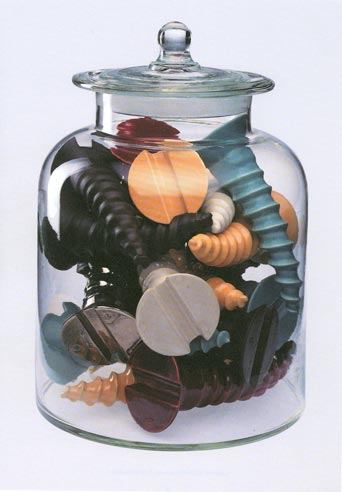 Since 1970, Mizuno’s work has evolved from functional dinnerware to abstract sculptural forms, from playful and humorous trompe l’oeil plates to richly layered sculpture informed by his evocative personal history, paralleling the development of the ceramics field itself in the late 20th century as it evolved from functional forms to a medium of full artistic expression. The exhibition is the first major museum exhibition to survey the work of this artist whose superbly crafted works, while firmly grounded in the traditions of the ceramic arts, extend to new forms in clay that defy traditional categories.
Since 1970, Mizuno’s work has evolved from functional dinnerware to abstract sculptural forms, from playful and humorous trompe l’oeil plates to richly layered sculpture informed by his evocative personal history, paralleling the development of the ceramics field itself in the late 20th century as it evolved from functional forms to a medium of full artistic expression. The exhibition is the first major museum exhibition to survey the work of this artist whose superbly crafted works, while firmly grounded in the traditions of the ceramic arts, extend to new forms in clay that defy traditional categories.
This exhibition catalogue designed by Takaaki Matsumoto includes a forward, interview with the artist, a biography and exhibition history, and the exhibition checklist of 48 artworks. The exhibition and publication trace the work of this Japanese-born, Los Angeles-based ceramist from 1971 through 2003.
- ISBN 0-97127772-3-0
- Published by the Long Beach Museum of Art
- Interview of the artist by Deborah McLeod, foreword by Museum Director Harold Nelson
- Format: hardcover
- Dimensions: 8-1/2 x 6-1/4 inches
- 96 page plus cover / 51 color plates
- Publication year: 2005 in conjunction with the exhibition of the same title at the Long Beach Museum of Art
- hard cover: $15.00
- Order number: FAP-118-H
Out of print
Fusing Traditions – Transformations
in Glass By Native American Artists
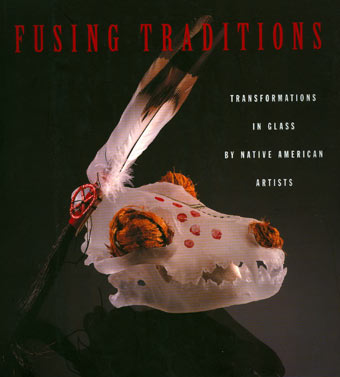 This publication begins to reverse the trend in many museum shows of exhibiting fine art objects influenced mostly by European artists and craftspeople. In recent years, a group of talented native Ameircan artists have selected glass as a medium for their creative expression. Illustrated in this beautiful publication, native American artists have turned inward, using the studio art methods initially implemented by the American Studio Glass Movement to create works of art inspired by objects of use and ritual to Native Americans. These artists draw upon their rich heritage to forge a contemporary Indian aesthetic. The shapes and designs in their contemporary work, while clearly connected to the iconography and imagery of their cultural heritage look rather original when transformed into the glass medium. Unlike their predecessors however, who learned their craft by apprenticeship within their own culture, these artists have chosen to study glass making at universities, art institutes and specifically the Pilchuck Glass School with Dale Chilhuly, David Svenson, and others. They have not only mastered this medium but have taken it to new dimensions, creating bybrid glass forms that blend European, American and Native traditions in dramatic and exciting ways.
This publication begins to reverse the trend in many museum shows of exhibiting fine art objects influenced mostly by European artists and craftspeople. In recent years, a group of talented native Ameircan artists have selected glass as a medium for their creative expression. Illustrated in this beautiful publication, native American artists have turned inward, using the studio art methods initially implemented by the American Studio Glass Movement to create works of art inspired by objects of use and ritual to Native Americans. These artists draw upon their rich heritage to forge a contemporary Indian aesthetic. The shapes and designs in their contemporary work, while clearly connected to the iconography and imagery of their cultural heritage look rather original when transformed into the glass medium. Unlike their predecessors however, who learned their craft by apprenticeship within their own culture, these artists have chosen to study glass making at universities, art institutes and specifically the Pilchuck Glass School with Dale Chilhuly, David Svenson, and others. They have not only mastered this medium but have taken it to new dimensions, creating bybrid glass forms that blend European, American and Native traditions in dramatic and exciting ways.
- ISBN: 1-877742-11-2
- published by: Museum of Craft & Folk Art, San Francisco
- Carolyn Kastner, Editor with essays by Roslyn Tunis, Preston Singletary, Kate Morris and Lloyd F. Herman
- format: softcover
- dimensions: 9.25″ x 9.25″
- 92 page plus cover / 32 color plates
- publication year: 2002
- softcover: LIMITED COPIES $19.95
- order number: FAP-117S
Out of print
Every Exit is an Entry:
The Life and Work of Liam O’Gallagher
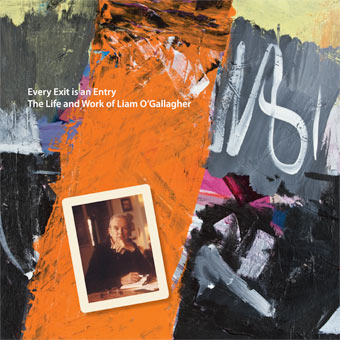 Every Exit Is An Entry: The Life and Work of Liam O’Gallagher shares the art, writing, and story of a highly original individual. A creative catalyst in 20th century art and literature, O’Gallagher spent a lifetime avoiding the spotlight. With his life-partner Robert Rheem and a close circle of friends, he inhabited the world of free-thinkers, painters, beat poets and sages, quietly impacting the lives of others. With unprecedented access to the artist’s archives and journals, author Kevin Wallace explores O’Gallagher’s life and work, joined by guest authors William Gray Harris, Whit Hibbard, Jan Herman, Cynthia Newby Luce, Michael McClure, India Supera, and Lewis Warsh, and insights from friends and associates, including Charles Amirkharian, Michael Bernsohn, Henry Dakin, Hammond Guthrie, Roshi Joan Halifax, Judith McBean, Paul Sand, & Gerd Stern.
Every Exit Is An Entry: The Life and Work of Liam O’Gallagher shares the art, writing, and story of a highly original individual. A creative catalyst in 20th century art and literature, O’Gallagher spent a lifetime avoiding the spotlight. With his life-partner Robert Rheem and a close circle of friends, he inhabited the world of free-thinkers, painters, beat poets and sages, quietly impacting the lives of others. With unprecedented access to the artist’s archives and journals, author Kevin Wallace explores O’Gallagher’s life and work, joined by guest authors William Gray Harris, Whit Hibbard, Jan Herman, Cynthia Newby Luce, Michael McClure, India Supera, and Lewis Warsh, and insights from friends and associates, including Charles Amirkharian, Michael Bernsohn, Henry Dakin, Hammond Guthrie, Roshi Joan Halifax, Judith McBean, Paul Sand, & Gerd Stern.
softcover ISBN – 10: 069200145X / 13: 9780692001455
hardcover ISBN – 10: 061527014X / 13: 9780615270142
published by Fine Arts Press
written by Kevin Wallace
format: softcover and clothbound with dustjacket
dimensions: 9.5” x 9.5”
136 page plus cover / 136 color plates
publication year: 2009
softbound: $35
hardbound: $50
order number: softcover: FAP-101-S / hardcover: FAP-101-H
Softbound:
Hardbound:
Charles Barth – A Kaleidoscope of Culture
 Forever fascinated by the color and culture of Mexico, Charles Barth: A Kaleidoscope of Culture captures the excitement of the country through depictions of its people and traditions in vibrant, richly detailed intaglio prints. Employing a variety of Mexican themes, Barth incorporates items and photographs collected over twenty-five years of traveling with his wife in Mexico. From collections of masks and costumes, he clothes his figures in an imagination that reflects the essence of Mexico. Many prints depict glimpses of Mexican daily life and festivals such as the Day of the Dead or the Guelaguetza in Oaxaca, Mexico. Other prints depict popular culture such as lucha libre or salsa dancing. Whatever the subject matter presented, color and detail combine to give the prints a life of their own. Places like Oaxaca, Mexico, can be magical and that magic is present in Barth’s work. Like most artists of Oaxaca, he is very much concerned with fantasy and storytelling. Above all, color is the key to Barth’s work. The colors, rich or gaudy, brilliant or garish, pulsating or flamboyant, contribute to the character of Mexico’s people, buildings and traditions. Vivacious colors activate Barth’s work with a seemingly glowing quality and provide the background for the exuberant way of life in Mexico.
Forever fascinated by the color and culture of Mexico, Charles Barth: A Kaleidoscope of Culture captures the excitement of the country through depictions of its people and traditions in vibrant, richly detailed intaglio prints. Employing a variety of Mexican themes, Barth incorporates items and photographs collected over twenty-five years of traveling with his wife in Mexico. From collections of masks and costumes, he clothes his figures in an imagination that reflects the essence of Mexico. Many prints depict glimpses of Mexican daily life and festivals such as the Day of the Dead or the Guelaguetza in Oaxaca, Mexico. Other prints depict popular culture such as lucha libre or salsa dancing. Whatever the subject matter presented, color and detail combine to give the prints a life of their own. Places like Oaxaca, Mexico, can be magical and that magic is present in Barth’s work. Like most artists of Oaxaca, he is very much concerned with fantasy and storytelling. Above all, color is the key to Barth’s work. The colors, rich or gaudy, brilliant or garish, pulsating or flamboyant, contribute to the character of Mexico’s people, buildings and traditions. Vivacious colors activate Barth’s work with a seemingly glowing quality and provide the background for the exuberant way of life in Mexico.
- softcover ISBN – 978-0-9819933-0-0
- hardcover ISBN – 978-0-9819933-1-7
- published by James Snidle Fine Art Publishing
- text by Mary Jane Gagnier
- translation by Rowena Galavitz
- format: softcover and clothbound with dustjacket
- dimensions: 9” x 12”
- 116 page plus cover / 50 color plates
- publication year: 2009
- softcover: $18.95
- hardcover $26.95
- order number: softcover: FAP-102-S / hardcover: FAP-102-H
Softcover:
Hardcover:
Robert Brady: Sculpture 1989—2005
 During the 1970s and 1980s, Bay Area artist Robert Brady established himself among the nation’s most original ceramic sculptors. His work was acquired by the San Francisco Museum of Modern Art, the Fine Arts Museums of San Francisco, the Oakland Art Museum, the Crocker Art Museum, the Stedelijk Museum, Amsterdam and many important private collections. This publication which accompanied the exhibition at the Palo Alto Art Center in 2006 is a long overdue survey of Brady’s sculpture in wood. Brady’s inventive wooden sculpture projects a powerful inner presence, like ritual objects in tribal art, Robert Brady is a master of figural abstraction whose work has evolved poetically from the flux of his own life, work with ceramics, and deep reveraence for materials.
During the 1970s and 1980s, Bay Area artist Robert Brady established himself among the nation’s most original ceramic sculptors. His work was acquired by the San Francisco Museum of Modern Art, the Fine Arts Museums of San Francisco, the Oakland Art Museum, the Crocker Art Museum, the Stedelijk Museum, Amsterdam and many important private collections. This publication which accompanied the exhibition at the Palo Alto Art Center in 2006 is a long overdue survey of Brady’s sculpture in wood. Brady’s inventive wooden sculpture projects a powerful inner presence, like ritual objects in tribal art, Robert Brady is a master of figural abstraction whose work has evolved poetically from the flux of his own life, work with ceramics, and deep reveraence for materials.
- ISBN – 0-9636922-7-5
- published by the Palo Alto Art Center
- written by Maria Porges, and Signe Mayfield
- format softcover and clothbound with color plate mounted on cover, no dustjacket
- dimensions: 7.25″ x 11.25″
- 88 page plus cover / 45 color plates with duotones
- publication year: 2006
- soft cover: $22
- order number: softcover: FAP-116-S
The Miniature Worlds of Bruce Metcalf
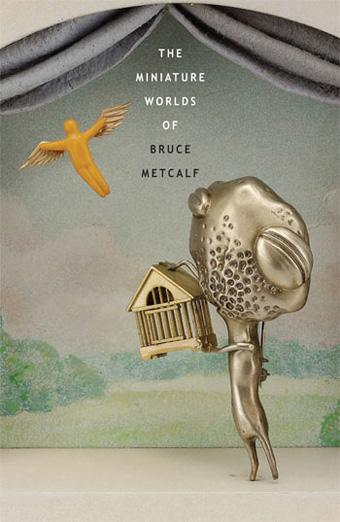 The Miniature Worlds of Bruce Metcalf was published to coincide with the artist’s exhibition at the Palo Alto Art Center in 2008. The exhibition and publication illustrates the artist’s interest in architecture, comics, and the narrative voice. Also examined are the social, moral, and political issues that Metcalf has raised in his essays. In his work, issues are acted out by his vulnerable protagonists on the stage of miniature worlds. Cast in silver, or carved in wood, Metcalf’s characters with their emotionally-distorted bodies manifest inflicted pain from human nature’s “dark side.” With their atrophied limbs, they are powerless in confronting Sisyphean ordeals in their worlds. Metcalf purposely leavens these conditions with wit. Physically big-headed, all Metcalf’s figures are born from cartoon traditions. These characters with big brains are strangely credible, as they ponder Metcalf’s overarching themes—the human condition, nurturing the juncture of nature and culture, and issues of dissent. As morally charged inventions, The Miniature Worlds of Bruce Metcalf reside in the same realms of imagination as Jonathan Swift’s Gulliver’s Travels and Lewis Carroll’s fabulous Through The Looking Glass (And What Alice Found There).
The Miniature Worlds of Bruce Metcalf was published to coincide with the artist’s exhibition at the Palo Alto Art Center in 2008. The exhibition and publication illustrates the artist’s interest in architecture, comics, and the narrative voice. Also examined are the social, moral, and political issues that Metcalf has raised in his essays. In his work, issues are acted out by his vulnerable protagonists on the stage of miniature worlds. Cast in silver, or carved in wood, Metcalf’s characters with their emotionally-distorted bodies manifest inflicted pain from human nature’s “dark side.” With their atrophied limbs, they are powerless in confronting Sisyphean ordeals in their worlds. Metcalf purposely leavens these conditions with wit. Physically big-headed, all Metcalf’s figures are born from cartoon traditions. These characters with big brains are strangely credible, as they ponder Metcalf’s overarching themes—the human condition, nurturing the juncture of nature and culture, and issues of dissent. As morally charged inventions, The Miniature Worlds of Bruce Metcalf reside in the same realms of imagination as Jonathan Swift’s Gulliver’s Travels and Lewis Carroll’s fabulous Through The Looking Glass (And What Alice Found There).
- ISBN – 978-0-9636922-8-3
- published by the Palo Alto Art Center
- written by Signe Mayfield, Bruce Metcalf and Dr. Vicky A. Clark
- format: soft cover and clothbound with dustjacket
- dimensions: 7.75″ x 11.25″
- 120 page plus cover / 74 color plates
- publication year: 2008
- softcover: out of print
- hardcover: out of print
- order number: softcover: FAP-115S / hardcover: FAP-115H
Out of print
Nathan Oliveira: The Painter’s Bronzes
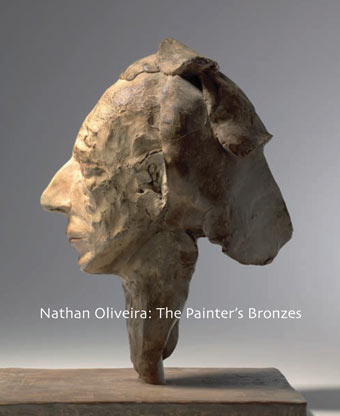 Nathan Oliveira : The Painter’s Bronzes is the first comprehensive publication to survey the sculptures, 1960—2008 of this internationally-celebrated artist. He first received national acclaim in 1959 as the youngest painter to be featured in the New Images of Man exhibition at the New York Museum of Modern Art. While his paintings have been heralded as part of the Bay Area Figurative Movement, they are, in fact, rooted in European Expressionism. Identified further as a pivotal figure in the revival of lithography and monotype, Nathan Oliveira was a Professor of Studio Art at Stanford University from 1964—1996. This publication was published to coincide with the first major exhibition of Oliveira’s sculpture at the Palo Alto Art Center in 2008.
Nathan Oliveira : The Painter’s Bronzes is the first comprehensive publication to survey the sculptures, 1960—2008 of this internationally-celebrated artist. He first received national acclaim in 1959 as the youngest painter to be featured in the New Images of Man exhibition at the New York Museum of Modern Art. While his paintings have been heralded as part of the Bay Area Figurative Movement, they are, in fact, rooted in European Expressionism. Identified further as a pivotal figure in the revival of lithography and monotype, Nathan Oliveira was a Professor of Studio Art at Stanford University from 1964—1996. This publication was published to coincide with the first major exhibition of Oliveira’s sculpture at the Palo Alto Art Center in 2008.
- ISBN – 978-0-9636922-9-1
- published by the Palo Alto Art Center
- written by Peter Selz and Signe Mayfield
- format: softcover and clothbound with dustjacket
- dimensions: 9.25″ x 11.25″
- 76 page plus cover / 41 color plates plus duotones
- publication year: 2008
- softcover: $25
- hardcover: $38
- order number: softcover: FAP- 114S / hardcover: FAP-114H
Softcover:
Hardcover:
Transforming Vision:
The Wood Sculpture of William Hunter,
1970—2005
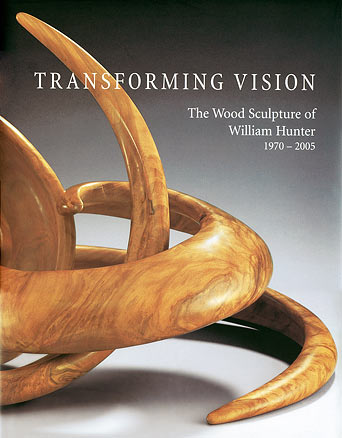 William Hunter is a major figure in the field of contemporary craft and a leading figure in contemporary wood art. Transforming Vision: The Sculpture of William Hunter, 1970—2005 is the first major publication on the artist and features work that encompasses over three decades of artistic exploration. In his insightful essay, curator Kevin Wallace traces Hunter’s work back to childhood interests in baseball, fishing and hand crafts, and coming of age during the turbulent and inspiring era of 1960s America. Inspired by the back-to-the-earth movement and philosophies of self-reliance and reinvention, William Hunter entered the field of contemporary wood turning during its formative stages and pioneered a new language in wood, evolving from a foundation in utilitarian forms to a vehicle for sculptural exploration. Investigating the medium’s rich expressive potential, Hunter advanced a new direction for contemporary wood art, and assisted in its emergence as a legitimate and highly regarded form of artistic expression.
William Hunter is a major figure in the field of contemporary craft and a leading figure in contemporary wood art. Transforming Vision: The Sculpture of William Hunter, 1970—2005 is the first major publication on the artist and features work that encompasses over three decades of artistic exploration. In his insightful essay, curator Kevin Wallace traces Hunter’s work back to childhood interests in baseball, fishing and hand crafts, and coming of age during the turbulent and inspiring era of 1960s America. Inspired by the back-to-the-earth movement and philosophies of self-reliance and reinvention, William Hunter entered the field of contemporary wood turning during its formative stages and pioneered a new language in wood, evolving from a foundation in utilitarian forms to a vehicle for sculptural exploration. Investigating the medium’s rich expressive potential, Hunter advanced a new direction for contemporary wood art, and assisted in its emergence as a legitimate and highly regarded form of artistic expression.
The sophistication and technical mastery of William Hunter’s work have become a recognizable signature and made him a major force in the field of contemporary wood sculpture. Transforming Vision places this work in a historical context, with commentary by curators, collectors and artists and stunning full color plates sharing the artist’s unique approach to the wood medium.
- softcover ISBN – 0-9712772-4-9
- hardcover ISBN – 0-9712772-4-9
- published by Long Beach Museum of Art, California
- text by exhibition curator Kevin Wallace, introduction by museum director, Hal Nelson
- format: softcover and clothbound with dustjacket
- dimensions: 9.5” x 12.25”
- 128 page plus cover / 115 color plates
- publication year: 2006
- softcover: $24.00
- order number: softcover: FAP-109-S / hardcover: FAP-109-H
Softcover:
Hardcover:
The Art of Vivika and Otto Heino
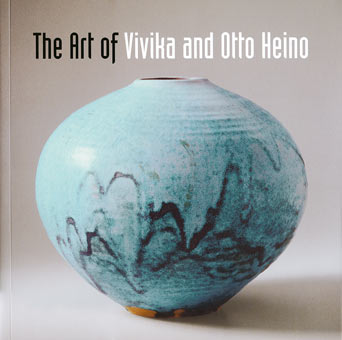 The Art of Vivika & Otto Heino documents the lives of two leading figures in 20th century ceramics. As teachers, they exerted a major influence on the work of generations of makers. As artists, their work has been prominently featured in hundreds of exhibitions, honored with innumerable awards, and now forms an essential part of the craft collections in dozens of museums. But, as Eudorah Moore, Founder and Director of the California Design Exhibitions, has pointed out, “Over and beyond the work, their great distinction was the early visibility they gave to the crafts, revealing the crafts as a way of life.”
The Art of Vivika & Otto Heino documents the lives of two leading figures in 20th century ceramics. As teachers, they exerted a major influence on the work of generations of makers. As artists, their work has been prominently featured in hundreds of exhibitions, honored with innumerable awards, and now forms an essential part of the craft collections in dozens of museums. But, as Eudorah Moore, Founder and Director of the California Design Exhibitions, has pointed out, “Over and beyond the work, their great distinction was the early visibility they gave to the crafts, revealing the crafts as a way of life.”
This elegant publication catalogues a traveling exhibition drawn from two simultaneous exhibitions: one at the Craft & Folk Art Museum, Los Angeles, celebrating the six decades of the Heinos’ life and work together; the other at the Ventura County Museum of History & Art, focusing on work created by Otto Heino since 1995. The Art of Vivika & Otto Heino presents a body of work that expresses a cumulative, intuitive knowledge of beauty, form and process, embracing both European and Far Eastern traditions.
- softcover ISBN – 0-9729361-3-0
- hardcover ISBN – 0-9729361-3-0
- published by the Ventura County Museum of History and Art, California
- text by exhibition curators Kevin Wallace and Tim Schiffer
- format: hard cover
- dimensions: 9.25” x 9.25”
- 88 page plus cover / 72 color plates
- publication year: 2005
- LIMITED EDITION only 2 copies available: $98.00
- order number: FAP-110-S
Songs of the Earth
Landscapes by Jack Stuppin
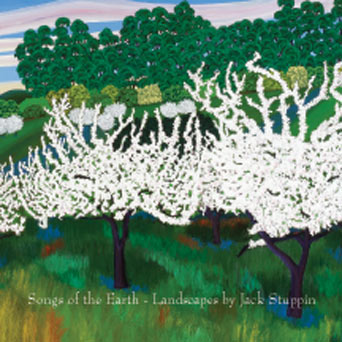 Jack Stuppin creates landscapes that celebrate nature, but he is certainly not a traditional plein-air artist. As Susan Krane of the San Jose Museum of Art explains, “Stuppin’s landscapes are amplified, as if quick glimpses that he has forever exalted and memorialized. The scenes he offers the viewer are held taut, orderly patterned and captured in brilliant Technicolor. They may remind us of the modernist masters of metaphorical landscapes (from Grant Wood to Marsden Hartley to Arthur Dove), and of images that are part and parcel of Americana.”
Jack Stuppin creates landscapes that celebrate nature, but he is certainly not a traditional plein-air artist. As Susan Krane of the San Jose Museum of Art explains, “Stuppin’s landscapes are amplified, as if quick glimpses that he has forever exalted and memorialized. The scenes he offers the viewer are held taut, orderly patterned and captured in brilliant Technicolor. They may remind us of the modernist masters of metaphorical landscapes (from Grant Wood to Marsden Hartley to Arthur Dove), and of images that are part and parcel of Americana.”
In his essay, highly-respected art critic Donald Kuspit relates the work to the writing of Walt Whitman, noting that the paintings are “…realistic and idealistic at the same time, reminding us that one without the other is existentially incomplete.”
- softcover ISBN – 978-0-938175-40-7
- hardcover ISBN – 978-0-938175-41-4
- published by the San Jose Museum of Art, California and Meridian Gallery, San Francisco, California
- written by Susan Landauer and Donald Kuspit
- format: softcover and clothbound with dustjacket
- dimensions: 9.25” x 9.25”
- 72 page plus cover / 43 color plates
- publication year: 2008
- softcover: $25
- hardcover: $35
- order number: softcover: FAP-105S / hardcover: FAP-105-H
Softcover:
Hardcover:
River of Destiny:
The Life and Work of Binh Pho
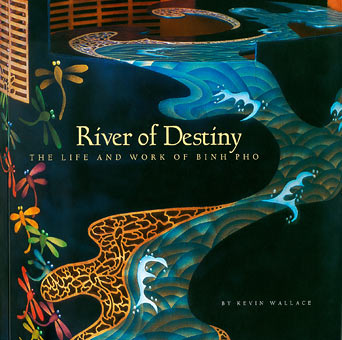 River of Destiny: The Life and Work of Binh Pho presents the art and story of an important Vietnamese-American artist. A leading figure in the new international movement in contemporary wood sculpture, Binh Pho utilizes modernist approaches to painting and sculpture to create bold new work that bridges the decorative arts with concerns for narrative and concept traditionally associated with contemporary art.
River of Destiny: The Life and Work of Binh Pho presents the art and story of an important Vietnamese-American artist. A leading figure in the new international movement in contemporary wood sculpture, Binh Pho utilizes modernist approaches to painting and sculpture to create bold new work that bridges the decorative arts with concerns for narrative and concept traditionally associated with contemporary art.
In his text, author and curator Kevin Wallace explores the connections between Binh Pho’s life experiences and his work. Tracing the artist’s inspiration back through Vietnamese and familial history, the narrative shares the artist’s struggle to follow his family to the U.S. following the Fall of Saigon, which included attempted escapes and time spent in a Communist “reeducation camp.”
Published in conjunction with a 2005 exhibition at the Long Beach Museum of Art, this publication presents a story of family, friendship, dreams, struggles, love and the intersection of life and art. Throughout the book, stunning reproductions of Pho’s artwork illustrate and illuminate his life story.
- softcover ISBN – 0-9729361-3-0
- hardcover ISBN – 0-9729361-3-0
- published by the Long Beach Museum of Art, California
- text by exhibition curator Kevin Wallace
- format: softcover and clothbound with dustjacket
- dimensions: 9.25” x 9.25”
- 88 page plus cover / 72 color plates
- publication year: 2005
- softcover: out of print
- hardcover: out of print
- order number: softcover: FAP-111-S / hardcover: FAP-111-H
- limited edition box set with original work of art: FAP-111-L
Softcover:
Out of print
Hardcover:
Out of print
Celebrating Nature:
Craft Traditions/Contemporary Expressions
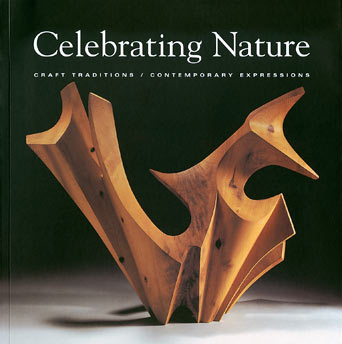 Celebrating Nature presents the state of the art of craft. These artists work in materials the earth offers—wood, clay, metal, stones and natural fibers—to create work that presents the wonder and beauty of the natural world.
Celebrating Nature presents the state of the art of craft. These artists work in materials the earth offers—wood, clay, metal, stones and natural fibers—to create work that presents the wonder and beauty of the natural world.
This catalogue is a snapshot of contemporary craft. These leading and emerging artists create work that will influence future generations. The works in this publication are a marriage of tradition and contemporary expression, folk art and modern sculpture.
- softcover ISBN – 0-9759162-0-3
- hardcover ISBN – 0-9729361-3-0
- published by the Craft & Folk Art Museum, Los Angeles
- text by exhibition curator Kevin Wallace
- format: softcover
- dimensions: 9” x 9”
- 76 page plus cover / 94 color plates
- publication year: 2004
- softcover: ON SALE FOR $16.95
- order number: softcover: FAP-112-S
Big Idea: The Maquettes of Robert Arneson
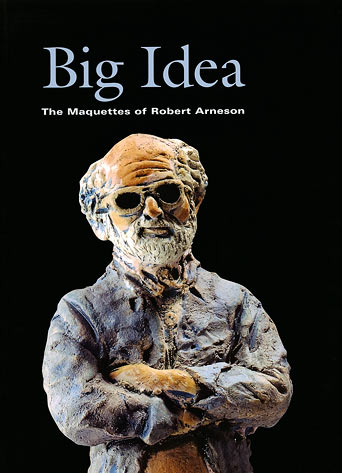 This award-winning catalogue presents, for the first time, the maquettes of Robert Arneson (1930 —1992), one of America’s most original, witty and iconoclastic artists, known for his pivotal role in establishing ceramics as a vital medium for contemporary figurative sculpture.
This award-winning catalogue presents, for the first time, the maquettes of Robert Arneson (1930 —1992), one of America’s most original, witty and iconoclastic artists, known for his pivotal role in establishing ceramics as a vital medium for contemporary figurative sculpture.
Ranging in size from 2 to 14 inches and in date from 1964 to 1992, the maquettes form a journal of intimate notations that chronicle the evolution of the artist and his prodigious imagination. Many of the maquettes represent Arneson’s first concepts for works, and their freshness and spontaneous execution illuminate his thought process in clay. The maquettes are presented with associated artist notebooks and studies on paper to provide a window into Arneson’s visual thinking.
- ISBN – 0-9636922-6-7
- published by the Palo Alto Art Center, California
- text by Daniel Rosenfeld, and Signe Mayfield
- format: softcover
- dimensions: 8.5” x 12”
- 96 page plus cover / 70 color plates
- publication year: 2002
- softcover: $35.95
- order number: FAP-113-S
Animal Myth and Magic:
Images from Pre-Columbian Textiles
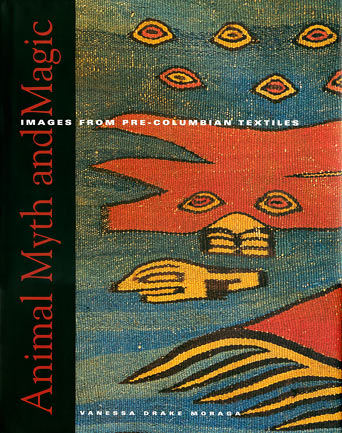 Animal Myth and Magic explores the central place and significance of animals in the Andean cosmovision through the prism of South American archaeology, anthropology, natural history and mythology. Illustrated with 155 marvelous images from pre-Columbian textiles, this unique anthology discusses over forty-five species, from the hummingbird and butterfly to the llama and jaguar. The depictions—from surreal to naturalistic, awe-provoking to whimsical, abstract to totemic—span a diversity of habitats and 2000 years of culture (Chavín to Inka).
Animal Myth and Magic explores the central place and significance of animals in the Andean cosmovision through the prism of South American archaeology, anthropology, natural history and mythology. Illustrated with 155 marvelous images from pre-Columbian textiles, this unique anthology discusses over forty-five species, from the hummingbird and butterfly to the llama and jaguar. The depictions—from surreal to naturalistic, awe-provoking to whimsical, abstract to totemic—span a diversity of habitats and 2000 years of culture (Chavín to Inka).
Key themes emerge: the feline, bird and snake shamanic archetypes; a fascination with magical transformation; a preoccupation with water and fertility in the arid, fragile ecologies of the desert and high sierra; and an intricate visual code based on the signs of the fang, claw, spotted pelt, whisker and wing.
This compelling information, and the extraordinary inventiveness and variety of mammals, birds, fish, reptiles, and insects represented in the textile art, provide an outstanding source of reference for all readers intrigued by animal symbolism, Native American art, and the vitality and creativity of the pre-Columbian imagination.
- hardcover ISBN – 0-9767774-0-1
- published by OLOLO Press
- written by Vanessa Drake Moraga
- format: clothbound with dustjacket
- dimensions: 9.75” x 12.25”
- 164 page plus cover / 155 color plates and 10 line drawings
- publication year: 2005
- hardcover: out of stock
- order number: hardcover: FAP-107-H



